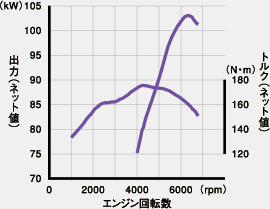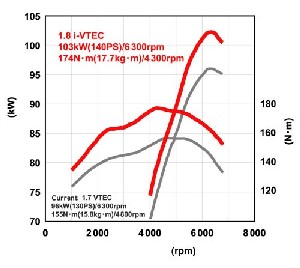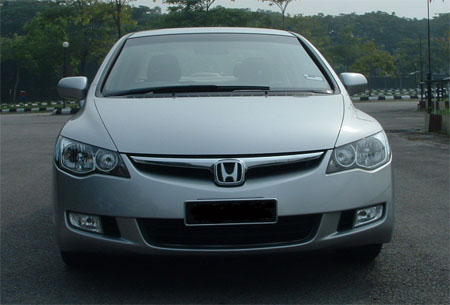

Dyno Results the new 8G Asian Civic 1.8S
The Honda Civic has been enjoying a nice revival in Asia since the launch of the latest 8th generation model. Here in Asia, Honda launched two 2 types, the 1.8S featuring the new SOHC i-VTEC R18A engine and the 2.0S featuring the revised 2.0l DOHC i-VTEC now coded as K20Z. Both are sold in sedan form only and usually sold with the revised 5AT gearbox though some lucky countries within ASEAN also has the 5MT option available.
Over the past month, I had on loan for test-drive and review both the Civic 1.8S and 2.0S. And I have been able to have both of them dyno'ed by our TOVA sponsor AMOIL MOTORSPORTS. With the completion of our special short technical overview of both the K20Z and R18A engines, I thought it would be most appropriate to continue with coverage on the new 8G Civic by featuring the results of the dyno sessions. Here we start first with the dyno results for the Civic 1.8S before we take focus on the Civic 2.0S in the following article.
Dyno Check - Stock 8G Honda Civic 1.8S i-VTEC


On the left is the dyno output for a completely stock Civic 1.8S i-VTEC with 5AT. Again for reference, the power/torque chart as published by Honda for the R18A SOHC i-VTEC engine is shown on the right. Note that the power unit listed on the graph is in kW. 140ps is equal to approx 103kW. Also note that the car being dyno'ed is a media review unit from Honda Malaysia so it has not gone through a proper run-in procedure. This may or may not have an impact on the ability of the R18A engine to deliver its best performance.
A stock Civic 1.8S i-VTEC 5AT as we can see from the chart delivers almost 110ps at the wheels when measured on a Dynojet. In absolute terms, this result is very good indeed. 110ps at the wheels works out to almost 79% which means that the new R18A engine-5AT gearbox combo incurs only slightly over 20% power loss. This of course means more of the engine power gets transfered to the front wheels and directly means better performance.
The dyno curves follows the stock power & torque curves like a glove, with max torque peaking exactly at 4,300rpm. Power on the other hand seems to continue to increase beyond the spec'ed point of 6,300rpm. The dyno result shows max power coming in at 6,500rpm. In fact more power would seem to be available had the dyno run been able to be extended beyond the 5AT's upshift point at 6,500rpm.
The other thing to note would be the air-fuel ratio which the R18A runs at. Again this is very consistent and almost completely flat at around 12.5:1 across the whole rpm band. Once again this is slightly rich.
Dyno Results : R18A vs D17A


In all Honda's technical presentations on the R18A that I have seen, it was always pointed out how the D17A was the base reference when designing the R18A and how it is designed to offer superior performance to that superseded engine. So it would be most interesting to see how the new Civic 1.8S compares on the dyno to the previous generation ES1/ES2 Civic 1.7. Unfortunately AMOIL cannot supply me with any dyno charts of the D17A. Nevertheless, in one of our older articles on Honda Malaysia's Limited Edition Civic RX, we did feature a mildly modified ES1 Civic 1.7 and we did publish a dyno chart for that car. So although we are not able to have a combined chart for easy comparison, we have put the individual dyno charts side by side above for comparison. For base reference, the combined power/torque chart that Honda has been using for the R18A vs D17A comparison is also on the right.
In our comparison, for a fair comparison, we need to take the lower powered result for the D17A because that was for the original stock engine. The higher powered result was for after a HKS Super-Power-Flow and AFR was added to the engine and then subsequently dyno-tuned. So a stock D17A will deliver almost 98ps at the wheels. Now compare this result to that for R18A - almost 110ps. This is around 12ps higher, for only an extra 10ps at the engine (140ps vs 130ps). This clearly shows how the engine/gearbox needs to be seen as a combo and how the new 5AT gearbox is superior to the 4AT unit used with the D17A. So while on paper the R18A delivers 10ps or around 7.7% higher max power, on the dyno and in real-life it delivers a bit more than that, around 9%. The other thing to note would be how the D17A starts to rolls off its power delivery after 6,000rpm whereas the R18A as noted above continues to increase in power well beyond the spec'd point and right until the pre-programmed shift-up point. This suggests that in comparison, the R18A is a more performance oriented engine than the old D17A.
While the D17A do represent a competant engine, I think the dyno results clearly shows how much better the new R18A engine is. It also shows the superiority of the new SOHC i-VTEC implementation/system, where the fact that the engine has a specialised economy mode does not mean it is compromised in power. So the R18A is truly both a performance oriented (within its design objective and market segment) and an economy oriented engine combined, truly a 'two-in-one' engine.
R18A versus 155ps K20A

Let's be more merciless now. The R18A does so well on the dyno, relatively, that it is natural that one wonders how it actually stacks up to the original (155ps) DOHC i-VTEC K20A engine that powers the last generation ET1 Civic 2.0 i-VTEC. While this latest generation of Civic has managed to revive a lot of the excitement that is associated with the Civic DNA, the truth is it was the original 7G ET1 Civic 2.0 i-VTEC that was responsible for starting the revival, at least here in Asia, because after so many years, it finally represented a Civic that could at least stir up some excitement in Civic enthusiasts. Indeed I still have fond memories of my test drive of the ET1.
The dyno chart on the left puts the results for both the new Civic 1.8S and the previous generation Civic 2.0 i-VTEC together for easy comparison. The obvious things apparent from the comparison are of course the superior low-end and high-end power of the K20A, due to its extra 200 c.c. displacement. An interesting factor however is how the R18A offers superior power in the mid-range between the range of 4,000 to 5,000rpm. This rpm range is quite important in daily driving especially when overtaking slower vehicles. The 'hole' in the middle of the K20A's torque and power curves have been the target of quite a bit of complaint by ET1 Civic 2.0 i-VTEC owners as it gives rise to lack-lustre response in the middle of WOT runs and we can see here clearly how Honda made sure the new Civic 1.8S do not suffer from this problem. NOT apparent from the dyno printouts would also be how much better the R18A sounds during WOT runs, especially on the dyno when the bonnet/hood is open.
Also, note how successful Honda has been in extracting 'torque of a 2.0l engine' from the R18A. On the dyno, note how close the R18A's max torque - 13.94 kgm - compared to the old K20A's max torque - 14.06kgm, only 0.12 kgm difference or less than 1% ! So, keeping in mind that the ET1 Civic was supposed to be the 'sporty' variant of the previous generation, it is very clear how much progress Honda has made with the new R18A engine. It truly is a very good engine indeed.
Conclusion

I think we have seen, from this article, how much work Honda R&D have put in when they designed and developed the new R18A engine, and how successful they have been in achieving their design objectives. As they say, the proof of the pudding is in its eating, and so one way of proving how good an engine is would be when we plunk the car on the dyno. And here the R18A has delivered very well indeed. I think this bodes very well for us Honda fans, and I for one am excited by the new R20A engine that has been developed for the new Honda Stream. We shall definitely check that out when the new Stream comes to ASEAN.
Wong KN
October 2006
© Temple of VTEC Asia and Temple of VTEC